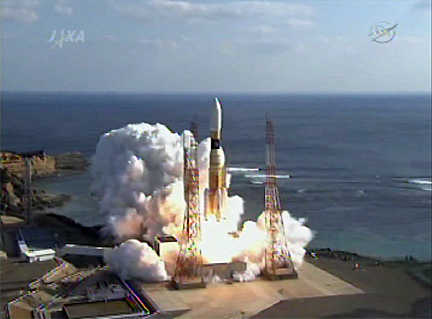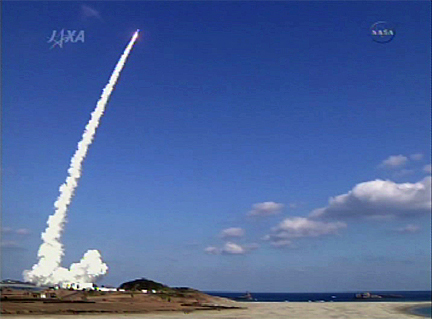Japanese HTV-2 cargo ship rockets into orbit, sets off after space station
01/22/2011 01:00 AM Filed in: International Space Station | Space News
By WILLIAM HARWOOD
CBS News
An unmanned cargo craft carrying nearly 8,500 pounds of critical equipment and supplies bound for the International Space Station blasted off from an ocean-side launch pad in southern Japan Saturday, rocketing smoothly into orbit and setting off after the lab complex.
Perched inside a protective nose cone atop a powerful Japanese H-2B rocket, the HTV-2 mission began with a picture-perfect blastoff from the Tanegashima Space Center at 12:37:57 a.m. EST (GMT+5) at roughly the moment Earth's rotation carried the launch pad into the plane of the space station's orbit.
The launching came two days late because of predicted bad weather, but conditions were acceptable for fueling Friday and the Japan Aerospace Exploration Agency -- JAXA -- cleared the spacecraft for launch.
Trailing a churning cloud of fiery exhaust from two hydrogen-fueled main engines and four strap-on boosters, the H-2B rocket quickly climbed from its seaside launch pad and then arced away to the southeast through a clear blue sky. The H-2B's first and second stages worked as planned and 15 minutes after liftoff, the HTV-2 cargo craft was released into its planned preliminary orbit
If all goes well, the automated 17.5-ton spacecraft, making only its second flight, will catch up with the space station Jan. 27, pulling to within about 30 feet and then holding position while astronaut Catherine "Cady" Coleman, operating the station's robot arm, locks onto a grapple fixture.
Assisted by Italian astronaut Paolo Nespoli, Coleman will move the spacecraft to the Earth-facing port of the station's forward Harmony module and lock it in place with a common berthing mechanism.
Developed by JAXA as a contribution to the space station program, the HTV measures some 32 feet long and 14.4 feet wide. Unlike Russia's unmanned Progress supply ship and the European Space Agency's Automated Transfer Vehicle, the HTV can carry both pressurized and unpressurized cargo, including equipment too big to pass through the space station's hatches.
For Japan's second cargo flight, the pressurized section of the cargo ship is loaded with 6,455 pounds of equipment and supplies in six cargo racks, including food and crew provisioning. The pressurized section also carries Japan's Kobairo gradient heating furnace, a crystal growth research facility that will be moved into the Japanese Kibo module.
The Expedition 26 astronauts plan to open a hatch leading to the pressurized cargo the day after berthing, but it will take several weeks to completely unload it.
An unpressurized cargo bay just behind the pressurized section carries a pallet loaded with a spare flex hose rotary coupler for the station's ammonia coolant system radiators and a cargo container loaded with equipment. The unpressurized cargo weighs 2,043 pounds.
The pallet will be extracted by the station's robot arm Feb. 1 and then maneuvered to the far end of the Kibo module on the left side of the station. A smaller Japanese robot arm then will lock on and move the pallet to an external porch used for Japanese experiments in the vacuum of space. The cargo pallet will be moved back to the HTV-2 later and re-inserted in its payload bay.
The cargo container and the flex hose rotary coupler, meanwhile, will be moved from the porch to the station's solar power truss between Feb. 2 and 4 by the station arm and a Canadian robotic attachment called the Special Purpose Dexterous Manipulator.
The HTV-2's two-month mission originally was planned to fall between visits by the shuttle Discovery and the Endeavour. But Discovery was grounded by external tank cracks following a Nov. 5 launch attempt, disrupting the near-term station schedule.
Discovery, now scheduled for launch Feb. 24, will dock at the Harmony module's forward port two Feb. 26. But the HTV-2, docked to Harmony's Earth-facing port, must first be moved to prevent possible damage from the shuttle's maneuvering thrusters as the shuttle approaches.
Once fully unloaded, the pressurized section of the HTV-2 will be loaded with trash and no-longer-needed equipment. The flight plan calls for Coleman to detach the spacecraft for good on March 28. The next day, the craft will fall back into the atmosphere and burn up.
JAXA currently plans to build and launch one HTV craft per year, although the agency could support two flights annually if necessary.
CBS News
An unmanned cargo craft carrying nearly 8,500 pounds of critical equipment and supplies bound for the International Space Station blasted off from an ocean-side launch pad in southern Japan Saturday, rocketing smoothly into orbit and setting off after the lab complex.
 |
| A powerful H-2B rocket blasts off from the Tanegashima Space Center in southern Japan, boosting a Japanese cargo module into space for a flight to the International Space Station. (Photo: NASA TV) |
The launching came two days late because of predicted bad weather, but conditions were acceptable for fueling Friday and the Japan Aerospace Exploration Agency -- JAXA -- cleared the spacecraft for launch.
 |
| Japan's HTV-2 cargo craft heads for orbit. (Photo: NASA TV) |
If all goes well, the automated 17.5-ton spacecraft, making only its second flight, will catch up with the space station Jan. 27, pulling to within about 30 feet and then holding position while astronaut Catherine "Cady" Coleman, operating the station's robot arm, locks onto a grapple fixture.
Assisted by Italian astronaut Paolo Nespoli, Coleman will move the spacecraft to the Earth-facing port of the station's forward Harmony module and lock it in place with a common berthing mechanism.
 |
| Four solid-fuel strap-on boosters help propel the H-2B rocket toward space. (Photo: NASA TV) |
For Japan's second cargo flight, the pressurized section of the cargo ship is loaded with 6,455 pounds of equipment and supplies in six cargo racks, including food and crew provisioning. The pressurized section also carries Japan's Kobairo gradient heating furnace, a crystal growth research facility that will be moved into the Japanese Kibo module.
The Expedition 26 astronauts plan to open a hatch leading to the pressurized cargo the day after berthing, but it will take several weeks to completely unload it.
An unpressurized cargo bay just behind the pressurized section carries a pallet loaded with a spare flex hose rotary coupler for the station's ammonia coolant system radiators and a cargo container loaded with equipment. The unpressurized cargo weighs 2,043 pounds.
The pallet will be extracted by the station's robot arm Feb. 1 and then maneuvered to the far end of the Kibo module on the left side of the station. A smaller Japanese robot arm then will lock on and move the pallet to an external porch used for Japanese experiments in the vacuum of space. The cargo pallet will be moved back to the HTV-2 later and re-inserted in its payload bay.
The cargo container and the flex hose rotary coupler, meanwhile, will be moved from the porch to the station's solar power truss between Feb. 2 and 4 by the station arm and a Canadian robotic attachment called the Special Purpose Dexterous Manipulator.
The HTV-2's two-month mission originally was planned to fall between visits by the shuttle Discovery and the Endeavour. But Discovery was grounded by external tank cracks following a Nov. 5 launch attempt, disrupting the near-term station schedule.
Discovery, now scheduled for launch Feb. 24, will dock at the Harmony module's forward port two Feb. 26. But the HTV-2, docked to Harmony's Earth-facing port, must first be moved to prevent possible damage from the shuttle's maneuvering thrusters as the shuttle approaches.
 |
| A computer graphic showing the HTV-2 cargo ship moments before capture by the International Space Station's robot arm. Berthing is planned for Jan. 27. (Photo: JAXA) |
Once fully unloaded, the pressurized section of the HTV-2 will be loaded with trash and no-longer-needed equipment. The flight plan calls for Coleman to detach the spacecraft for good on March 28. The next day, the craft will fall back into the atmosphere and burn up.
JAXA currently plans to build and launch one HTV craft per year, although the agency could support two flights annually if necessary.